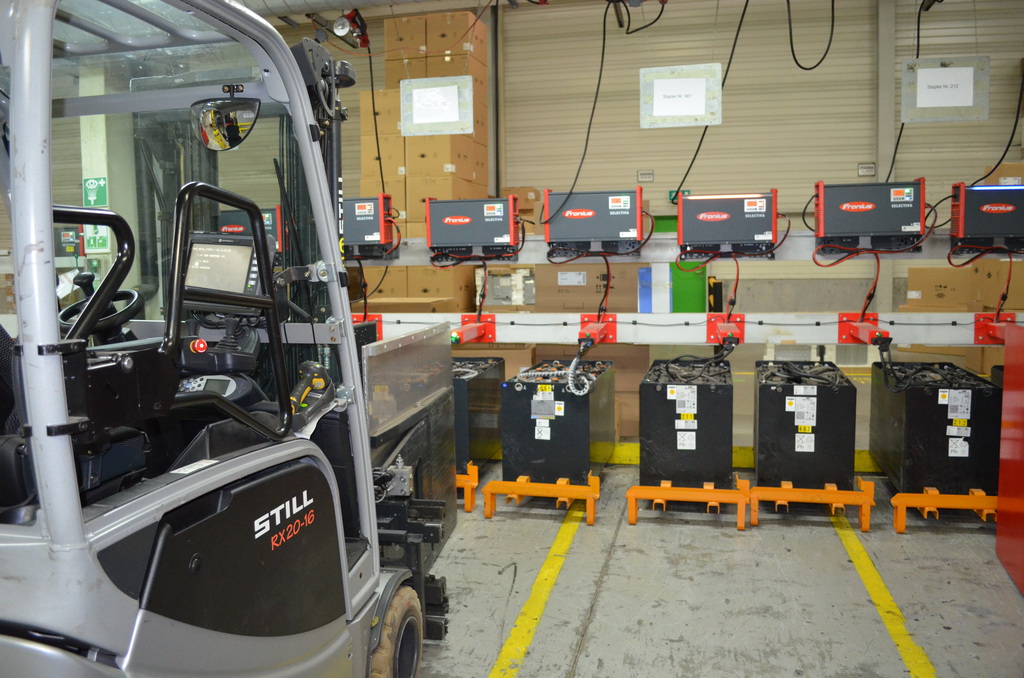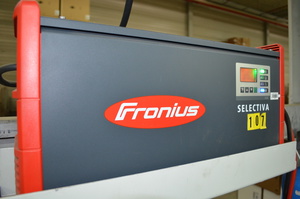

|
Edward Lowton
Editor |


|
| Home> | Handling and Storing | >Batteries and chargers | >Hot ovens and cool batteries |
Hot ovens and cool batteries
04 April 2019
Neff produces built-in stoves, ovens and extractor fans at its plant in northern Baden-Württemberg. To transport raw materials, semi-finished parts and appliances, it uses electric forklift trucks – and battery charging technology from Fronius.

Selectiva battery charging systems and the intelligent Cool Battery Guide Easy management system has enabled Neff to optimise use of its battery pool and reduce operating costs for its fleet of forklift trucks.
Neff's fleet of electric forklift trucks includes manual lift trucks, order picking trucks, lifting platforms, reach trucks and end loaders with load capacities of several tonnes. “Our employees use these trucks to supply the assembly lines with raw materials and semi-finished parts, as well as to transport the final products,” explains Jörg Martin, who is responsible for the vehicle fleet and charging management at Neff.
The battery-powered trucks are quiet, produce no exhaust emissions and require very little maintenance. Since the company works with several shift patterns, the trucks need to be available at all times. For this reason, many of them have back-up batteries.
The batteries are charged at several central stations and single charging points, which are located in various places across the extensive factory halls. “When deciding where to install the infrastructure, we made sure that journeys would be short for our drivers and that the charging stations would be easily accessible,” adds Martin. Neff has established a battery pool that works according to the FIFO principle (first in, first out): an employee attaches the empty battery from their forklift to a free battery charging system and takes the battery which has been fully charged for the longest and has already cooled down. “This ensures even utilisation of the battery pool and extends the service life of the expensive lead batteries,” explains Martin.
Charging management with unified technology
Several years ago, the situation was different. Batteries were selected at random and drivers often took the first one they got their hands on, instead of the one that had been charged for the longest. This resulted in irregular and incomplete charging cycles, as well as insufficient cooling periods for the batteries. This in turn lead to a dangerous warming of the battery interior, which significantly reduced the service life – and had considerable cost implications for Neff. The company therefore decided to introduce a comprehensive charging management strategy. “This included buying our preferred forklift truck models with the same types of battery,” explains Martin. “When it came to charging technology, we presented our suppliers with very particular requirements.” Instead of the numerous battery charging systems that come as standard with many forklift trucks, Neff now relies on technology from Fronius.
“To begin with, we of course put the battery charging systems through their paces to see if they were worth investing in,” remembers Jörg Martin. The Fronius technology won them over on several points, one of which was the ability to charge batteries flexibly with different voltages and capacities using the Selectiva chargers. “This meant that we were able to reduce the range of models we had when it came to our charging technology, which has allowed us to prevent user errors as employees don’t have to deal with a new device every time,” explains Martin. The charging quality was said to be significantly higher than with comparable technologies – and with significantly lower energy consumption.
Energy efficient and gentle charging
The reason for this is the Ri charging process developed by Fronius. This charging process does not follow a fixed characteristic; instead it adapts every time according to the capacity, age and condition of the connected battery. “Every charging process is therefore unique and only the amount of energy actually required is used,” explains Robert Petzina, a technical consultant at Fronius Germany. Calculations at Neff revealed that the domestic appliance manufacturer could save up to 30% on the energy required for charging by choosing Selectiva devices over other processes. And not only that: the gentle process also reduces harmful warming of the batteries, significantly extending the service life of the batteries at the same time. “Looking at it as a whole, this has opened up significant savings potential in terms of the operating costs for our forklift fleet,” reports Martin. “It didn’t take us long to decide to adopt the Fronius technology.”
Today, Neff is using around 80 Selectiva devices with power categories ranging from 2 kW to 8 kW. Batteries are charged with operating voltages from 12 to 80V. Thanks to their compact dimensions and low weight, they can be mounted on the wall and take up very little space. “They could not be easier to use,” says Michael Osswald, the truck workshop foreman. “The driver simply plugs the battery into any device and the automatic voltage detection and the Ri charging process take it from there.” An LED indicator on the device shows the state of charge of the respective battery at a glance. “Since we started using Fronius technology, there have been considerably fewer instances of incorrect operation by our staff, as well as damage to the batteries and charging systems,” says a delighted Osswald.
Straight to the coolest battery
In order to further improve the utilisation of the battery pool, Fronius has installed the information and management system Cool Battery Guide Easy on some of the charging stations. “A control unit processes the signals from the individual battery charging systems and uses an additional blue LED strip to show which battery has been fully charged for the longest and is therefore the coolest,” says Petzina. “This means that the user is intuitively led towards the correct battery.” The Fronius devices are also compatible with the Philadelphia Scientific management system, which is also used at the company. Even utilisation of the battery pool means that the batteries retain their capacity and performance for as long as possible. “This meant that we could also reduce the total number of batteries in our pool,” explains Osswald. “This has saved us additional investment costs.”
When it comes to equipping the charging stations and charging points, Fronius is on hand with consultancy services and makes sure that any restraints and safety rules are complied with. Neff is also extremely satisfied with the range of services offered by Fronius. “They thoroughly explained how to operate the new battery charging systems, and the integrated USB interface means that updates and additional characteristics are uploaded in a flash,” says Jörg Martin. The Fronius experts are available whenever there is a problem – but this has, so far, not been a service Neff has needed to call on.
“The devices are very low-maintenance and even dusty and dirty environments don’t affect them,” adds Michael Osswald. “We also now have less work when it comes to the batteries. We don’t have to top them up with water as often because the batteries don’t heat up as much during charging.” Old battery charging systems are gradually being replaced with Fronius technology. “We are saving energy, our batteries last longer and the availability of the fleet is guaranteed at all times,” summarises Martin. “What more could we want?”
- Charger collaboration
- TIG welding simulation
- Complete charging systems
- Fronius UK to host Back to the Future of Welding event
- Charge cooler, drive further
- Customised data documentation
- Technology designed for manual steel welding
- Warehouse efficiency event
- Efficiency boost
- Battery charging technology on show at LogiMAT 2018



















